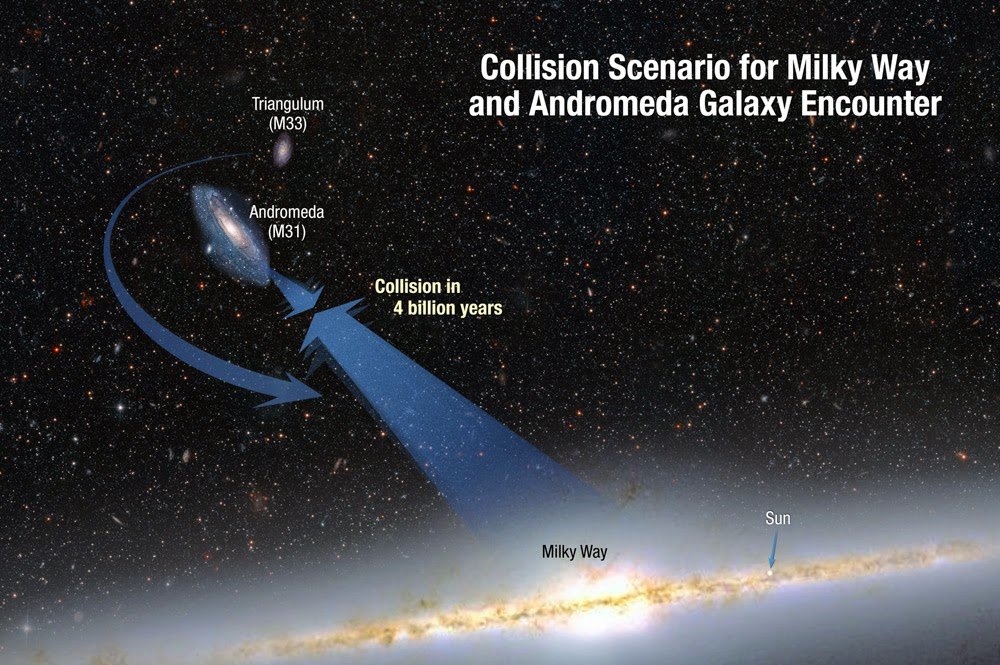Collision Between The Milky Way And Andromeda Galaxy
Question: When will the Miky Way and Andromeda Galaxy collide?
Answer: The collision and merger between our Milky Way galaxy and the nearby Andromeda galaxy will take place 4 billion years from now.
The Andromeda and Milky Way galaxies are, in fact, the two most massive galaxies in the Local Group of about 30 to 50 galaxies travelling through space as a collection that is approximately 10 million light-years across.
Due to the strength of the gravitational attraction between the Andromeda and Milky Way galaxies, astronomers have long known that these two are destined for an encounter.
Due to the collision, it is likely the sun will be flung into a new region of our galaxy, but our Earth and solar system are in no danger of being destroyed.

Andromeda (also known as M31) is now 2.5 million light-years away, but it is inevitably approaching the Milky Way under the mutual pull of gravity between the two galaxies and the invisible dark matter that surrounds them both.
Although the galaxies will plow into each other, stars inside each galaxy are so far apart that they will not collide with other stars during the encounter. However, the stars will be thrown into different orbits around the new galactic center. Simulations show that our solar system will probably be tossed much farther from the galactic core than it is today.
Andromeda and Milky Way are both spiral galaxies and when they collide, an elliptical galaxy – nicknamed Milkomeda – will be formed.
What has remained unknown, however, is whether this encounter will be a head-on collision a miss or a miss, glancing blow.
The timing for the collision depends much on Andromeda’s tangential or lateral, motion to the Milky Way. For now, astronomers cannot measure this motion because it’s too slow, to detect with the available telescopes and processing techniques of the past.
MessageToEagle.com
source: NASA Science
Related Posts
-
 Emilia Plater: National Female Hero Of Polish And Lithuanian People
No Comments | Apr 21, 2017
Emilia Plater: National Female Hero Of Polish And Lithuanian People
No Comments | Apr 21, 2017 -
 Auroville – A City Free From Politics, Money And Religion
No Comments | Aug 27, 2018
Auroville – A City Free From Politics, Money And Religion
No Comments | Aug 27, 2018 -
 Angry People Live Longer
No Comments | Feb 25, 2016
Angry People Live Longer
No Comments | Feb 25, 2016 -
 Bad And Good Karma Depends On Us – We Are Architects Of Our Own Fate
No Comments | Aug 14, 2018
Bad And Good Karma Depends On Us – We Are Architects Of Our Own Fate
No Comments | Aug 14, 2018 -
 Mercury: Highly Toxic Metal That Is Liquid At Room Temperature
No Comments | Oct 15, 2016
Mercury: Highly Toxic Metal That Is Liquid At Room Temperature
No Comments | Oct 15, 2016 -
 How Is A Rainbow Formed?
No Comments | Feb 2, 2016
How Is A Rainbow Formed?
No Comments | Feb 2, 2016 -
 Why Do Chameleons Change Colors In Unusual Ways?
No Comments | Jul 17, 2016
Why Do Chameleons Change Colors In Unusual Ways?
No Comments | Jul 17, 2016 -
 Mysteries Of The Yellow Emperor – The ‘Son Of Heaven’ From Regulus
No Comments | May 10, 2014
Mysteries Of The Yellow Emperor – The ‘Son Of Heaven’ From Regulus
No Comments | May 10, 2014 -
 Fantastic Biological Street Lighting: Using Glowing Plants And Trees As An Energy Source
No Comments | Jun 2, 2016
Fantastic Biological Street Lighting: Using Glowing Plants And Trees As An Energy Source
No Comments | Jun 2, 2016 -
 Unraveling The Secrets Behind Pope’s Mitre Shaped Like A Fish And The Dogon Connection
No Comments | Apr 9, 2017
Unraveling The Secrets Behind Pope’s Mitre Shaped Like A Fish And The Dogon Connection
No Comments | Apr 9, 2017

